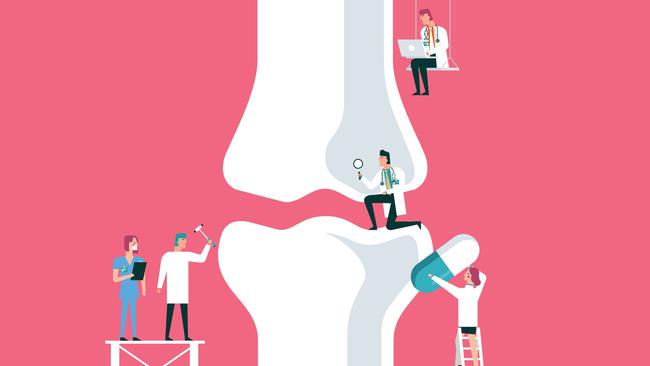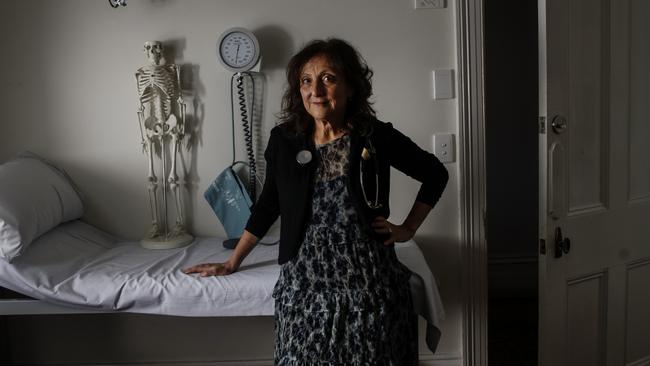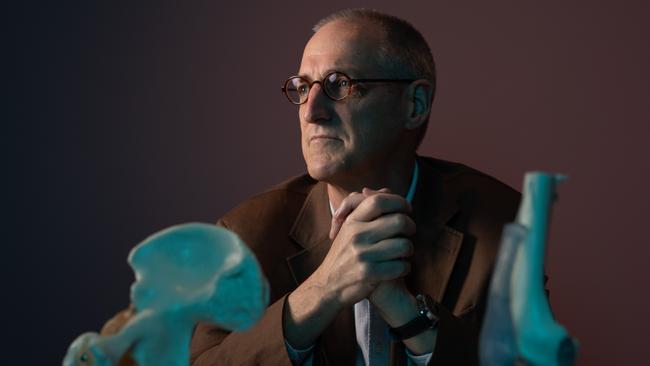Why some medical procedures do more harm than good
Medical procedures that don’t help the patient, overdiagnosis, the ‘medicalisation of normal’… two doctors lift the lid.

While many medical students take the Hippocratic Oath or a similar pledge before graduating (reciting lines like First, do no harm), we’ve ended up with a healthcare system that’s one of the greatest threats to human health. Our own experience as doctors and researchers has shown that much of medicine doesn’t do what it’s supposed to do: improve health. Modern medical care is designed to maximise the number of encounters with the system, constantly prescribing, operating, testing and scanning, and prioritising business over science. It’s a system rife with perverse incentives and unintended consequences producing health care without necessarily improving the health of the recipients of that care.
We’re both doctors in the field of musculo- skeletal medicine. (Buchbinder is a rheumatologist in Melbourne; Harris is an orthopaedic surgeon in Sydney.) We’re also internationally acclaimed academics in science-based medicine. In our research, our aim is to determine the true value of specific medical practices, which is often very different from their perceived value. We’re both highly published professors: between us we’ve published about a thousand scientific and lay articles. (Harris is also the author of a popular book, Surgery, The Ultimate Placebo (2016), which exposed the lack of effectiveness of many surgical procedures.)
Many people have written about the harms and overtreatment in modern medicine. Leading medical journals and global movements have taken on the challenge of overtreatment, medical harm, overdiagnosis and the medicalisation of “normal”. There are regular sections devoted to tackling the problem in the British Medical Journal (“Too Much Medicine”) and the Journal of the American Medical Association (“Less Is More”). Choosing Wisely, a clinician-led initiative that identifies the top five tests, treatments or procedures doctors and patients should question within each field of medicine, now has national branches in many countries. Unfortunately, these concepts haven’t broken through to become common knowledge or accepted by everyone.
We’re not suggesting for a minute that doctors are malicious or deliberately advising ineffective or harmful treatments. Many remain unaware of the criticisms and continue to act in good faith. We’re suggesting that doctors who base their practices on what’s commonly accepted, or on what they perceive to be effective, are often, unknowingly, wrong. And that’s bad for everyone.
There are, of course, highly successful medical therapies, such as chemotherapy for childhood leukaemias, which have saved lives; and hip replacement and cataract surgery, which have improved the quality of life for millions. But many other medical interventions, despite having proven ineffective and even harmful, remain in common use. Astoundingly, it has been estimated that about one-third of medical care is of no value, while another 10 per cent is actually harmful. Even when unhelpful or harmful practices have declined, it has usually taken many years, often decades. For example, arthroscopy to treat painful knees due to wear and tear was first found to be ineffective almost 20 years ago, but its use only started waning about a decade ago, and in some places hasn’t declined at all.

Knee arthroscopy, a procedure that involves inserting a camera and surgical instruments into the knee through small keyholes, is one of the most common surgical procedures in the world. It’s done for “degeneration in the knee” – things like osteoarthritis, and cracks, splits and tears in the small cartilages called menisci. Many studies published since the early 2000s have shown the procedure to be no more effective than placebo or exercise therapy for most conditions, yet the rates of surgery continued to rise throughout the 2000s.
In the studies, patients in both groups largely improved, but those treated with arthroscopy didn’t improve any more than those treated with the comparison treatment, or placebo surgery. When surgeons see these improvements after performing knee arthroscopy for their patients with degenerative knees, it seems logical to them that the improvement was a direct result of their treatment. Because of the logical “shortcut” humans make, observational evidence is very compelling for surgeons.
While the numbers of knee arthroscopies performed in some regions (such as Norway and Australia) have fallen significantly, in many countries and regions they have not, and in others they continue to rise. Yet even the falls that we have seen have only occurred since 2011, many years after the initial evidence was produced. It will probably take a few more decades for the rates to be anywhere near what they should be – for degenerative conditions, close to zero.
A similar scenario is playing out in shoulder surgery. One of the most common surgical procedures for shoulder pain is a “decompression” for presumed “impingement” of the deep shoulder tendons (called the rotator cuff) as they pass between the shoulder joint and the bones above it. It involves an arthroscopy of the shoulder and shaving of some bone (acromioplasty) to stop it “impinging” on the rotator cuff tendons. Two studies have now shown that surgery is no better than placebo surgery. The people in the placebo group received everything the surgery group did (the anaesthetic, surgical incisions, insertion of cameras and often other procedures) but not the acromioplasty. Both placebo studies, from the UK and Finland, made big news when published in 2018.
But the procedure was already a topic of debate among shoulder specialists, many believing it offered no benefit and others believing it was valuable and often needed. Importantly, previous studies of the surgery compared with non-operative (exercise) controls had also shown that it was no more effective than non-surgical treatment.
One of the most common procedures in medicine is cardiac stenting, which is worth billions to the medical and device industries. The procedure involves inserting a stiff metal tube into a narrowed heart artery to widen it. The stent is normally inserted under X-ray control, fed in from a blood vessel in the groin or arm. On the face of it, it makes sense to try to widen or unblock a narrowed artery just as you would a blocked water or sewerage pipe, and doctors have become very good at it. They can even pass a stent up through a completely blocked artery.
The procedure is often done on patients in whom a narrowed blood vessel has been found using angiography (injecting dye into the bloodstream and X-raying the arteries). The patient may have had symptoms but not necessarily a heart attack, and sometimes they haven’t had symptoms at all. The temptation to open a narrowed artery is very strong; it just seems to make so much sense. Sometimes, however, things that seem straightforward and logical at first start to lose their appeal on closer inspection. For example, if the patient wasn’t having a heart attack and they already had a completely (or near completely) blocked vessel, how was their heart still working? What happens to the stents – do they block up again? What are the possible complications from having the procedure? What about the anticoagulant drugs that need to be taken for the rest of the patient’s life, to stop the stent from blocking up again – do they cause complications, like bleeding?
The simplest and most important question, though, for this and any other procedure in medicine, is this: is doing the procedure better for the patient than not doing it? What would have happened had the stent not been inserted? One way to answer that question is to do a controlled study with two groups – to insert stents in some people and not insert them in others.
This exact study, called the Courage trial, was published in 2007, and involved people who would commonly be treated with a stent. It randomly divided more than 2000 patients with severe coronary artery disease who had “stable angina” (episodic chest pain but not an acute heart attack) into a stent group and a no-stent group. Both groups received best medical care comprising the usual drug treatment. The results showed that stenting offered no additional benefit over good medical treatment (the drugs) alone. People who had received the stents did not die less often or have fewer heart attacks.
Despite these results, clinical practice didn’t change much. Doctors argued that although stenting might not reduce the chances of dying or having a heart attack, it still might reduce episodes of angina (episodic chest pain). After years of continued stenting of millions of people with known coronary artery disease but stable angina, an even better type of study was published in 2017, a randomised placebo-controlled trial called Orbita. It included the same type of patients as the Courage trial – those with severe narrowing of the coronary arteries and stable angina. But this time the doctors gave one group of patients a stent, and pretended to give the other group a stent (i.e. a placebo). The groups were assigned at random and neither the patients nor the people providing the follow-up care knew who got what.
This time the outcome they were most interested in was symptoms such as how long the patients could exercise for and how frequent were their episodes of chest pain. As in the other trial, stenting did not help any more than the pretend stenting for any of the outcomes measured. A further trial comparing stenting to medical care without stenting in more than 5000 people with moderate or severe heart disease was published in 2020; it also showed no difference in the outcomes between the two groups.
While not all stents are currently performed for people with stable angina, many are. (The results of these studies do not apply to people with acute heart conditions or those having a heart attack.) The ongoing debate about the value of stenting in people with coronary artery disease and stable angina has led to some interesting developments. Hospitals and doctors in the US have been penalised under the False Claims Act for defrauding the government by charging Medicare for this unnecessary care. This is very rare in medicine, but it’s worth noting that hospitals investigated under this Act decreased stenting at a greater rate than did similar hospitals that weren’t charged with fraud. Despite all the evidence and the penalties, however, the rates of unhelpful and costly cardiac stenting remain high internationally.

Doctors and patients can be fooled into believing that treatment has worked because many health problems, such as tennis elbow, headaches and influenza, are self-limiting, which means they improve over time without any treatment. This is known as the “natural history” of the condition: what happens if we do nothing. This is why every treatment for the common cold and even an acute episode of non-serious low back pain appears to work – the appearance (observation) is an illusion that can be exposed and explained by science (experimental studies). People with both conditions improve over time and the treatment is irrelevant.
A common fallacy is that people with low back pain need imaging to identify the precise cause of the pain so that the right treatment can be prescribed. More than 60 per cent of patients and at least a third of doctors believe this, but imaging is likely to find lots of abnormalities (e.g. bulging discs, osteoarthritis and narrowed nerve canals). And finding them is likely to result in overtreatment. Even with the advent of sensitive tests such as CT scans and MRI scans, in the majority of cases we cannot identify the precise cause of the problem. Various abnormalities detected in these imaging tests, especially the more advanced types of imaging, are extremely common in people without back pain. They also increase with age, so many simply reflect normal age-related changes.
While some of these abnormalities may be associated with the presence of pain, there is no way of knowing whether they are the cause of the problem in an individual patient or just incidental. Knowing that these abnormalities are present may not actually help either, as the treatment is usually the same regardless of the imaging findings. In fact, most people who have an episode of pain get better quickly, and this happens irrespective of any treatment.
Overall, less than 1 per cent of people who visit their GP with acute low back pain will have a serious cause for their pain, and even in the emergency department that rate is less than 5 per cent. The reality is that many people with low back pain get imaging when they don’t really need it. Considering that most of us will have back pain at some time or another, and about half of us will be sufficiently worried to see a doctor, that’s a lot of unnecessary imaging.
But where’s the harm in having your back scanned? Surely it’s better to know exactly what’s going on and make sure it’s nothing serious. For some people this might be reassuring, but for many it’s likely to be a source of more anxiety rather than less. For others, unwarranted imaging of the spine not only exposes them to unnecessary radiation if they have an X-ray or CT scan, it’s also likely to lead to unnecessary treatments, including opioid prescriptions and surgery. For example, while a CT or MRI scan might show a bulging disc this diagnosis is unhelpful, as almost all people develop bulging discs as they age, and it might have nothing to do with the pain. A doctor might think it does, though, and prescribe strong pain medication, or might refer the patient to a surgeon, who may in turn offer the patient surgery. The more advanced the imaging, the more likely it will find abnormalities, so the greater the chances of being overtreated for no gain.
While it’s highly likely that doctors overestimate how much care patients really want, there’s no doubt that changes in societal norms have led to more demands for tests by patients. Some of this has been driven by overzealous selling of the value of tests by vested interests. But as in the low back pain example, some of this is driven by misconceptions among both clinicians and the general public about the value of different tests.
Avoiding unnecessary treatment is not avoiding responsibility. Failure to treat isn’t the same as failure to care. Often the reason behind a doctor’s bias towards treating versus not treating is that they don’t see not treating as an option. When told that their preferred treatments are ineffective, doctors will often respond: “What else do you expect us to do? We have to do something.” They’re often blind to the alternative of not doing the treatment – they just don’t see it as an option.
But any decision between treatment options based on the balance of benefit and harm includes the option of not intervening at all. Just like any treatment option, not treating someone also has potential benefits and harms that can be weighed up. And when explained to the patient in those terms, and delivered with compassion and assurance that the situation can be reassessed in the near future, avoiding treatment might be the best thing for the patient. Not treating can be a success.
We love our roles as doctors. We regularly experience the joy of healing – for example, by watching a fracture heal in good alignment after surgical fixation, or seeing a case of severe inflammatory arthritis resolve with modern drugs – and we want to preserve the trust we enjoy. We also want to make it clear that we believe that most, if not all doctors are trying to help their patients. We haven’t set out to deliberately erode trust in doctors. Rather, our aim has been to bring knowledge of the problems with modern medicine to a wider audience in the hope that by understanding the problems, we can focus on what needs to change. We would like many more doctors (and patients) to experience the joy of healing that comes from a more informed understanding of the true benefits of medicine and its true harms.
We discuss many treatments and tests used in medicine, but this shouldn’t be taken as individual medical advice. We encourage potential patients and patients who are contemplating changes in their health care to discuss any of the points raised in this article with their doctor.
Rachelle Buchbinder is a physician specialising in rheumatology, Director of the Monash-Cabrini Department of Musculoskeletal Health and Clinical Epidemiology at Cabrini Hospital and a Professor of Clinical Epidemiology at Monash University. Ian Harris is an orthopaedic surgeon at Liverpool, St George and Sutherland hospitals, Professor of Orthopaedic Surgery at UNSW Sydney and an Honorary Professor at the University of Sydney.
Edited extract from Hippocrasy: How Doctors are Betraying their Oath, by Rachelle Buchbinder and Ian Harris (NewSouth, $32.99), out next week.

To join the conversation, please log in. Don't have an account? Register
Join the conversation, you are commenting as Logout